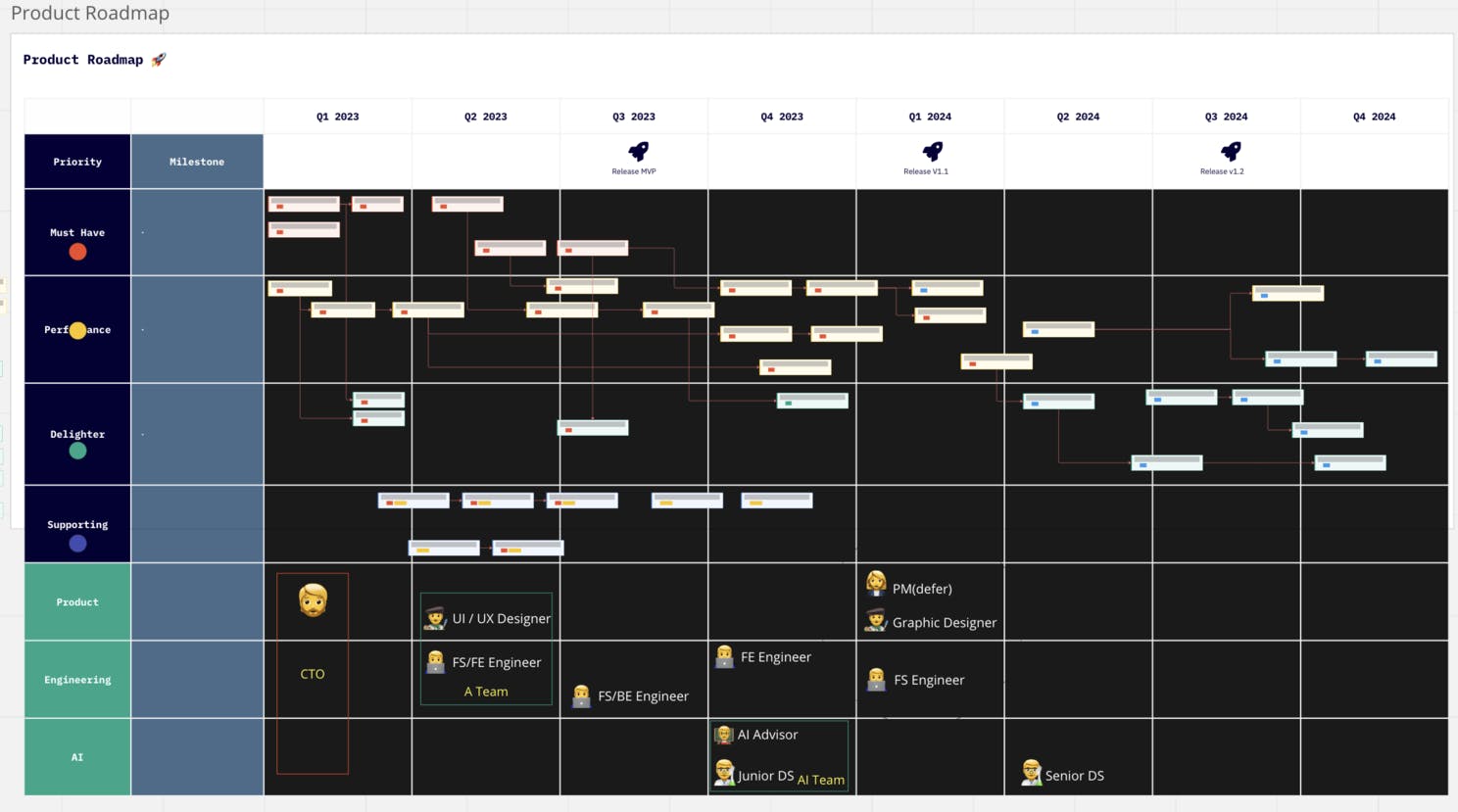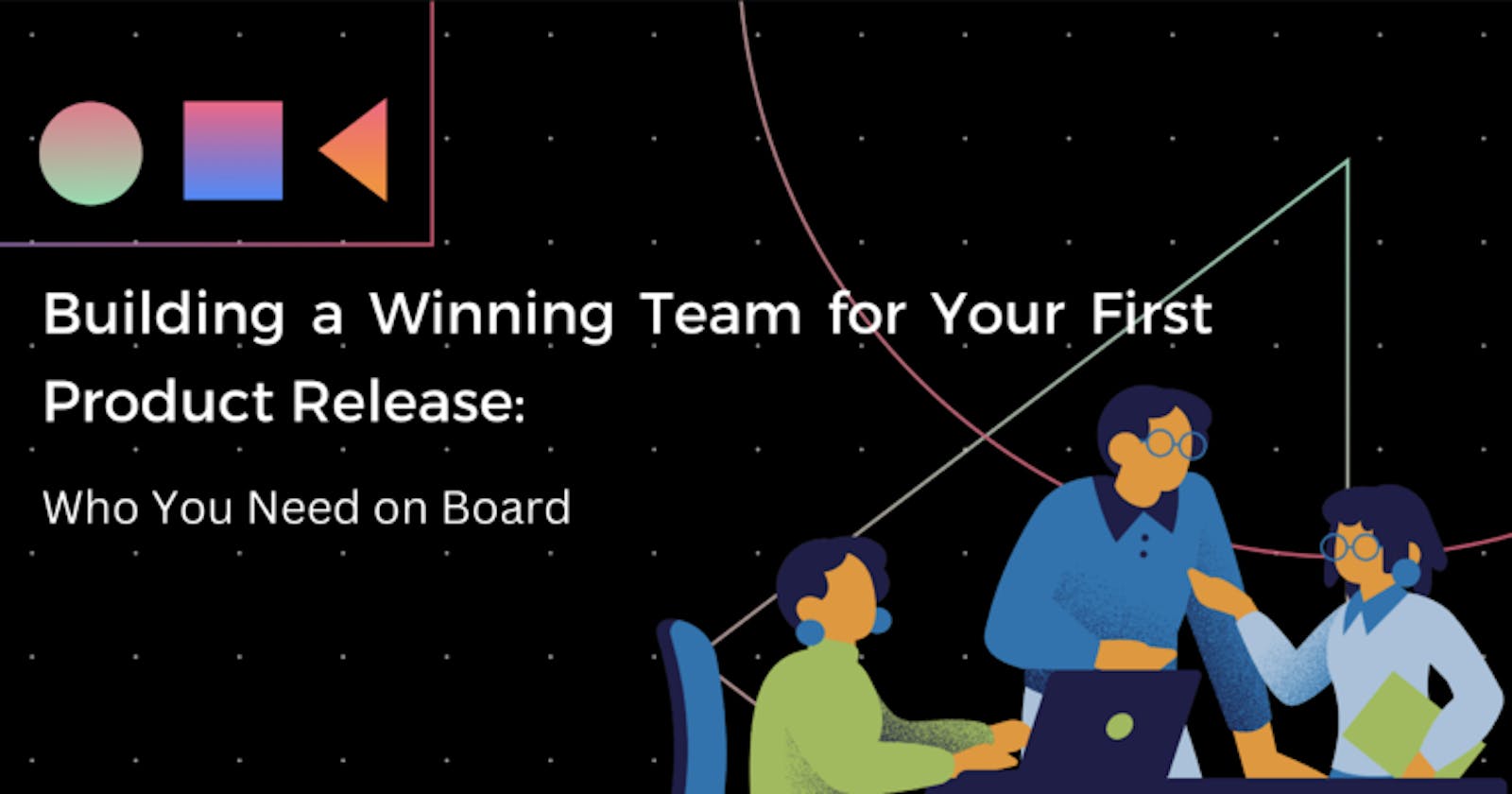Table of contents
- Key roles needed for a successful product release - The A team
- Finding the right talent for your early-stage startup
- Outsourcing vs in-house team building
- Creating a collaborative team culture for product development
- Tips for effective communication within your team
- Common challenges and how to overcome them
- Best practices for managing your team during the product release process
- Conclusion: Investing in a winning team for a successful product release
As an entrepreneur, launching your first product is a significant milestone in your startup journey. It is the culmination of months or even years of hard work, research, and development. But to ensure that your product release is successful, you need to assemble a winning team.

Hiring is a high-value and high-effort task, that should be done next.
Key roles needed for a successful product release - The A team
I learned the concept of the A team first in the book the lean product playbook (Dan Olsen). An A team comprises skills that ensure great UX. I went a little further to include a full-stack engineer and an optional AI engineer ( if you are building an AI product )
To launch a product successfully, you need to have a team that can handle various aspects of the product development process. The following are the key roles that you need to fill:
Frontend Engineer
A front-end engineer is responsible for creating and implementing the user interface (UI) design of your product. They ensure that your product is user-friendly and visually appealing. They should have a good understanding of HTML, CSS, and JavaScript and one modern framework like React / next for web or React native / Swift for Native apps.
UI/UX Designer
A UI/UX designer is responsible for creating a user-centered design for your product. They are involved in the entire design process, from conducting user research to creating wireframes and prototypes. They work closely with the front-end engineer to ensure that the final product is intuitive and easy to use.
Full Stack Engineer
A full-stack engineer is responsible for both the frontend and backend development of your product. They ensure that your product has the necessary functionalities and that it runs smoothly. They should have a good understanding of programming languages such as Python, Ruby, or Javascript and be equipped with one framework eg MERN stack.
AI / DS Engineer ( optional )
An AI / Data Science engineer is responsible for implementing machine learning algorithms into the product. They work closely with the full-stack engineer to ensure that the product is scalable and can handle high traffic. A good AI engineer should have experience in machine learning algorithms, and data analysis, and be familiar with popular AI libraries such as TensorFlow, PyTorch, or Scikit-learn.
Should you have a Product manager?
Ideally in the initial stage, there are not of people to actually " Manage" and in my experience, the technical cofounder should have a basic understanding of product management themselves. If your product is highly experiment-driven and you have sufficient funds, it can be wise to have PM otherwise for expertise you should have a product advisor/consultant who can occasionally review the key product decisions and methodologies.
Finding the right talent for your early-stage startup
Finding the right talent can be challenging. You need to find people who can work effectively in a startup environment, are passionate about your product, and are willing to take on multiple roles. Here are some tips for finding the right talent:
Look for people with experience in your industry
Look for people who have experience in your industry, as they will be familiar with the challenges and opportunities that come with it. You can find these people through networking events, online job boards, or LinkedIn.
Platforms to consider
Angelist - A startup focuses recruitment platform and my favorite of all.Remote.co - Remote-only candidatesMy Talent Network - https://amanin.tech/talent-network , hire@amanin.tech
Hire for attitude, not just skills
Skills are essential, but attitude is just as important. Look for people who are passionate about your product and are willing to learn and grow with your startup.
Ask - " What's the most difficult challenge you faced and how you overcome it?"
Consider hiring interns or freelancers
Interns or freelancers can be a cost-effective way to fill key roles in your startup. They may not have as much experience as full-time employees, but they can bring fresh perspectives and ideas to your team.
Outsourcing vs in-house team building
When building your team, you have two options: outsourcing or in-house team building. Outsourcing involves hiring contractors or freelancers to complete specific tasks or projects. In-house team building involves hiring full-time employees to work on your product development. Here are some pros and cons of each option:
Outsourcing
Pros:
Cost-effective
Access to a wider pool of talent
Flexibility
Cons:
Lack of control over the process
Communication challenges
Security concerns
In-house team building
Pros:
More control over the process
Better communication
Increased security
Cons:
Higher costs
Limited pool of talent
Less flexibility
If you decide on outsourcing though, keep flexibility in the scope of project and communicate clearly the delivery timeline and standup routine.
Creating a collaborative team culture for product development
Set clear goals and expectations
Ensure that everyone knows what they need to do and how they will contribute to the success of the project. Use open collaboration tools such as Trello and Notion very early on and make it a ritual to document everything you do include tasks, Communication, and standup.

Have clear product roadmap and milestones
Encourage open communication
Create an environment where people are comfortable sharing their thoughts and ideas. Reward people for opening up and speaking freely.
Foster a sense of ownership
Ensure that everyone feels invested in the success of the project and is willing to take ownership of their work. Hold regular huddles with everyone on the team to discuss the overall progress and where help is needed.
Tips for effective communication within your team
Use collaboration tools
Use collaboration tools such as Slack or Trello to keep everyone on the same page. These tools can help you stay organized and ensure that everyone is aware of what needs to be done.

My notion tech notion template
Notion Resource
You can get my Notion tech template and other startup resources at store.amanin.tech
Schedule regular check-ins
Schedule regular check-ins with your team to ensure that everyone is on track and has the support they need.
Be clear and concise
Avoid using jargon or technical terms that may confuse team members.
Common challenges and how to overcome them
Lack of resources
Lack of resources is a common challenge for early-stage startups. To overcome this, focus on building a team that is passionate and committed to your product. Look for cost-effective solutions, such as hiring interns or freelancers.
Communication breakdowns
Communication breakdowns can lead to delays or misunderstandings. To overcome this, ensure that everyone is on the same page and that communication channels are open.
Technical issues
Technical issues can be challenging to overcome, especially if you do not have a technical background. To overcome this, consider hiring a technical advisor or consultant.
( You can reach out to me at hey@amanin.tech or comment if you need tech /product advise )
Best practices for managing your team during the product release process
Managing your team during the product release process can be stressful. Here are some best practices for managing your team:
Stay organized
Stay organized and have a clear timeline for the product release process. Ensure that everyone knows what their role is and what needs to be done.
Celebrate milestones
Celebrate milestones along the way to keep your team motivated and energized.
Be flexible
Be flexible and willing to adjust your plans as needed. The product development process is not always straightforward, and you may need to pivot or change direction.
Conclusion: Investing in a winning team for a successful product release
Building a winning team is essential for the success of your product release. You need to find the right talent, create a collaborative team culture, and communicate effectively. Remember that launching a product is not without its challenges, but with the right team in place, you can overcome any obstacle. Invest in your team, and they will invest in your product.
If you are in the early stages of your product and need some help, feel free to reach out to me or comment your question here for everyone.

